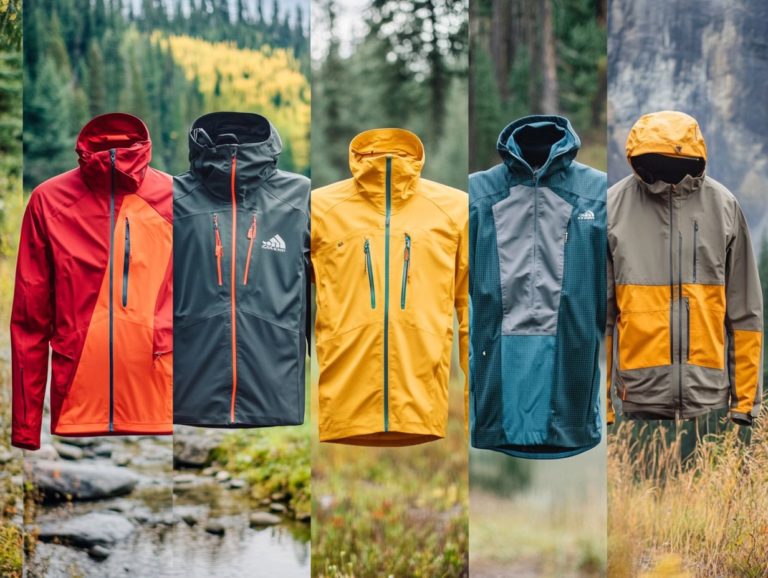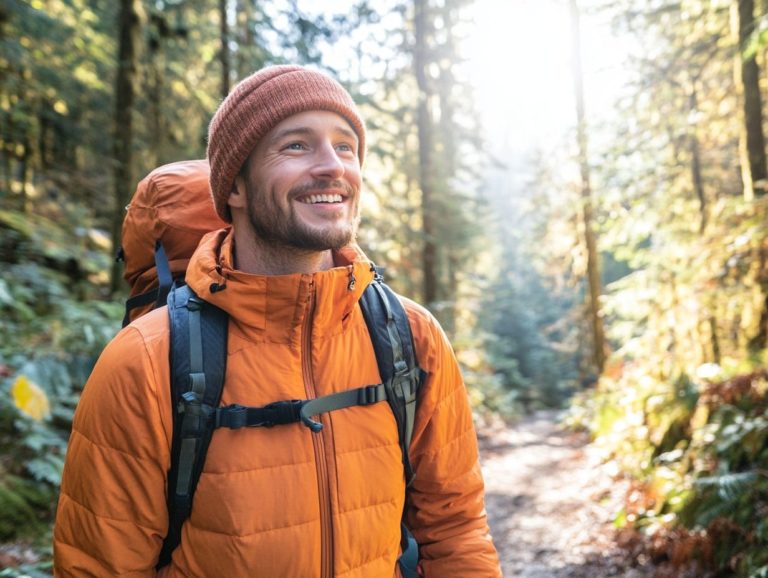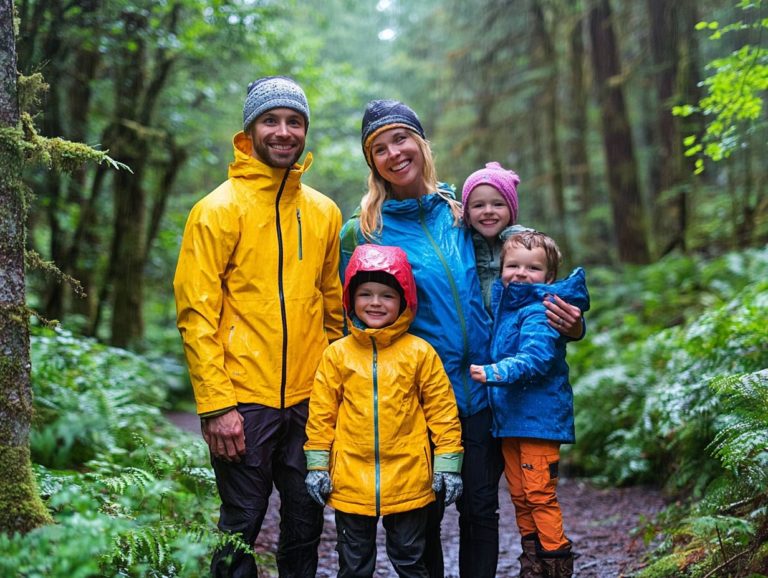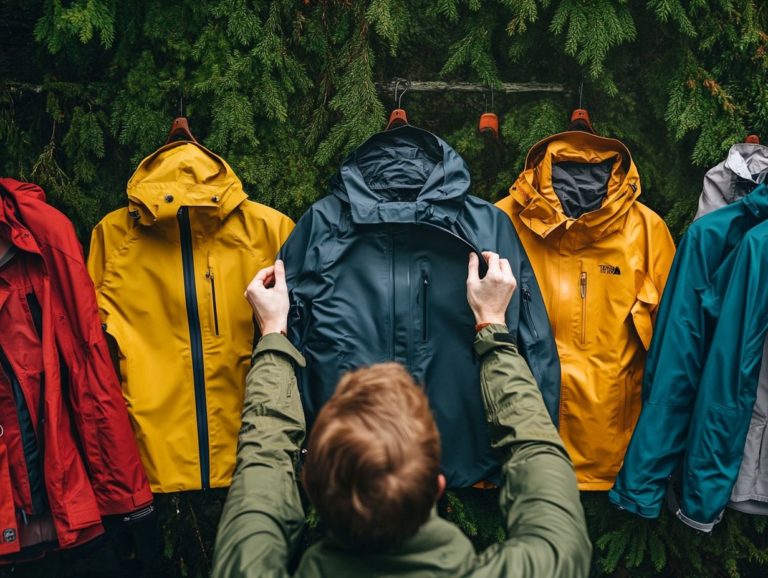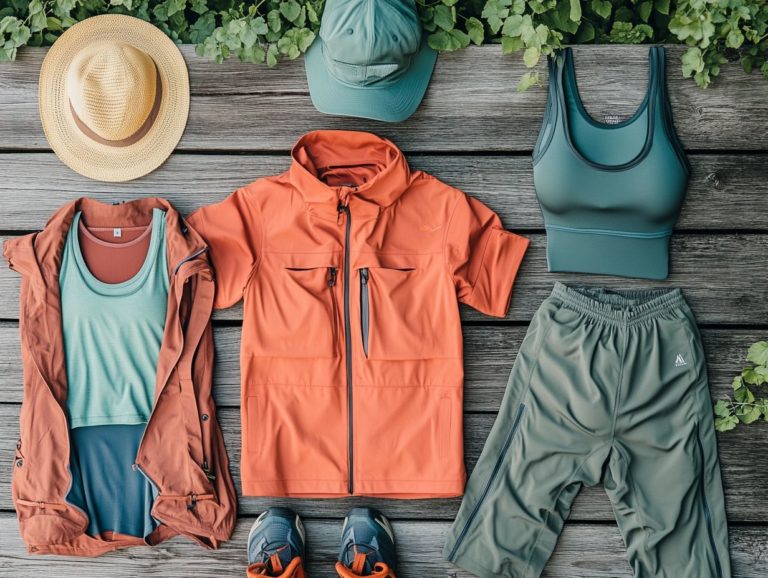How to Choose the Right Backpack for Hiking
When it comes to hiking, your backpack transcends the role of a mere bag; it becomes your lifeline on the trail.
Selecting the right one can dramatically impact whether your adventure is a delightful experience or a grueling ordeal. Get ready to learn how a great backpack can transform your hiking adventures! This article delves into the essential role a quality backpack plays in a successful hike, emphasizing crucial aspects such as size, fit, and material.
You ll explore various types of backpacks and uncover effective packing tips that can elevate your journey. Are you prepared to enhance your hiking experience? Let s dive in!
Contents
- Key Takeaways:
- Importance of Choosing the Right Backpack for Hiking
- Factors to Consider When Choosing a Backpack
- Types of Hiking Backpacks
- Tips for Properly Packing a Hiking Backpack
- Frequently Asked Questions
- What brands should I consider when looking for outdoor gear?
- What factors should I consider when choosing a backpack for hiking?
- What size backpack should I get for overnight hiking trips?
- Should I prioritize weight or durability when choosing a backpack for hiking?
- What type of backpack straps should I look for in a hiking backpack?
- Are there specific features to look for in a hiking backpack?
- Should I try on backpacks before purchasing one for hiking?
Key Takeaways:

- A good backpack is essential for a successful hike as it provides comfort, support, and organization for your gear.
- When choosing a backpack, consider size, fit, material, and features to ensure it meets your specific hiking needs.
- Properly packing your backpack by distributing weight, packing essentials, and adjusting straps will ensure a comfortable and balanced hike.
Importance of Choosing the Right Backpack for Hiking
Selecting the perfect hiking backpack is crucial for ensuring you have an enjoyable and safe experience on the trails. Finding the right backpack is crucial to your adventure! It significantly affects how comfortable, organized, and efficient you are in managing your outdoor gear.
A thoughtfully designed backpack not only meets your specific needs but also enhances your ability to navigate various terrains. You’ll be able to carry essentials such as water, snacks, and safety gear with ease. Additionally, if you’re planning to relax during your outdoor adventures, knowing how to choose the right hammock for camping can further improve your experience. With the proper fit, weight distribution, and volume, your backpack can turn a challenging trek into a delightful adventure, making it a critical part of your hiking journey.
Therefore, recognizing the significance of weight, capacity, and comfort features is vital when choosing your ideal hiking companion.
Why a Good Backpack is Essential for a Successful Hike
A quality backpack is critical for a successful hike, ensuring your comfort and safety as you navigate different trails. It allows you to immerse yourself in the experience rather than getting bogged down by discomfort or strain.
The right pack is designed to support your body ergonomically, featuring adjustable straps and a secure hip belt to evenly distribute weight. Additionally, choosing the right gear, including hiking socks, helps minimize fatigue and prevent injuries, so you can trek longer without feeling weighed down.
An organized interior with compartments for your gear and supplies provides easy access to essentials like water bottles and snacks. It also helps maintain your balance by keeping everything in its rightful place.
With durable materials, the backpack is built to withstand various weather conditions and rugged terrains, enhancing your overall hiking experience.
Factors to Consider When Choosing a Backpack
When selecting a backpack for hiking, it s essential to consider several critical factors to ensure it meets your specific needs and enhances your outdoor experience. You ll want to pay attention to weight, volume, fit, and comfort. A well-fitted pack distributes weight evenly and allows for optimal movement on the trails.
Durability is another key aspect; think about the materials used in construction and the overall design of the backpack. Look for features like organizational pockets, adjustment options, and comfort enhancements such as load lifters (straps that help lift the weight of your pack off your shoulders) and padded straps, as they can significantly impact usability and overall satisfaction.
Size and Capacity
The size and capacity of a backpack are essential elements to consider, especially when you re planning multiweek expeditions or day hikes. These factors dictate how much gear you can comfortably carry.
As you select a hiking backpack, you’ll encounter a spectrum of sizes, typically measured in liters. You might find small daypacks around 20-30 liters for short outings or larger models that exceed 70 liters, designed for extended trips. The choice hinges on your planned activity: for a brief excursion, a compact pack might be all you need, while longer adventures call for ample space to accommodate essentials like sleeping gear, cooking equipment, and extra clothing. To make the best choice, refer to this guide on choosing the right backpack for hiking.
Brands like Osprey, The North Face, and Gregory provide a variety of options tailored to meet different needs, making it easier for you to find the perfect fit for your unique adventure.
In summary, choosing the right backpack can enhance your hiking experience tremendously. Don’t wait select the perfect backpack for your next adventure and enjoy the journey ahead!
Fit and Comfort
Fit and comfort are essential when selecting the perfect hiking backpack. The right adjustments can elevate your trekking experience and significantly reduce strain on your body.
To achieve that ideal fit, consider both your torso length and hip circumference. Make sure the backpack aligns perfectly with your physique. Use a measuring tape to determine your torso length, which runs from the base of your neck to the top of your hips.
An adjustable harness system will help balance the weight, enhancing comfort and making your hike much more enjoyable.
Padded shoulder straps relieve pressure on your shoulders during long hikes. Also, don’t forget about the hip belt. A snug fit around your hips ensures that more weight transfers to your sturdy hip area, granting you greater comfort and less fatigue on extended trails.
Material and Durability
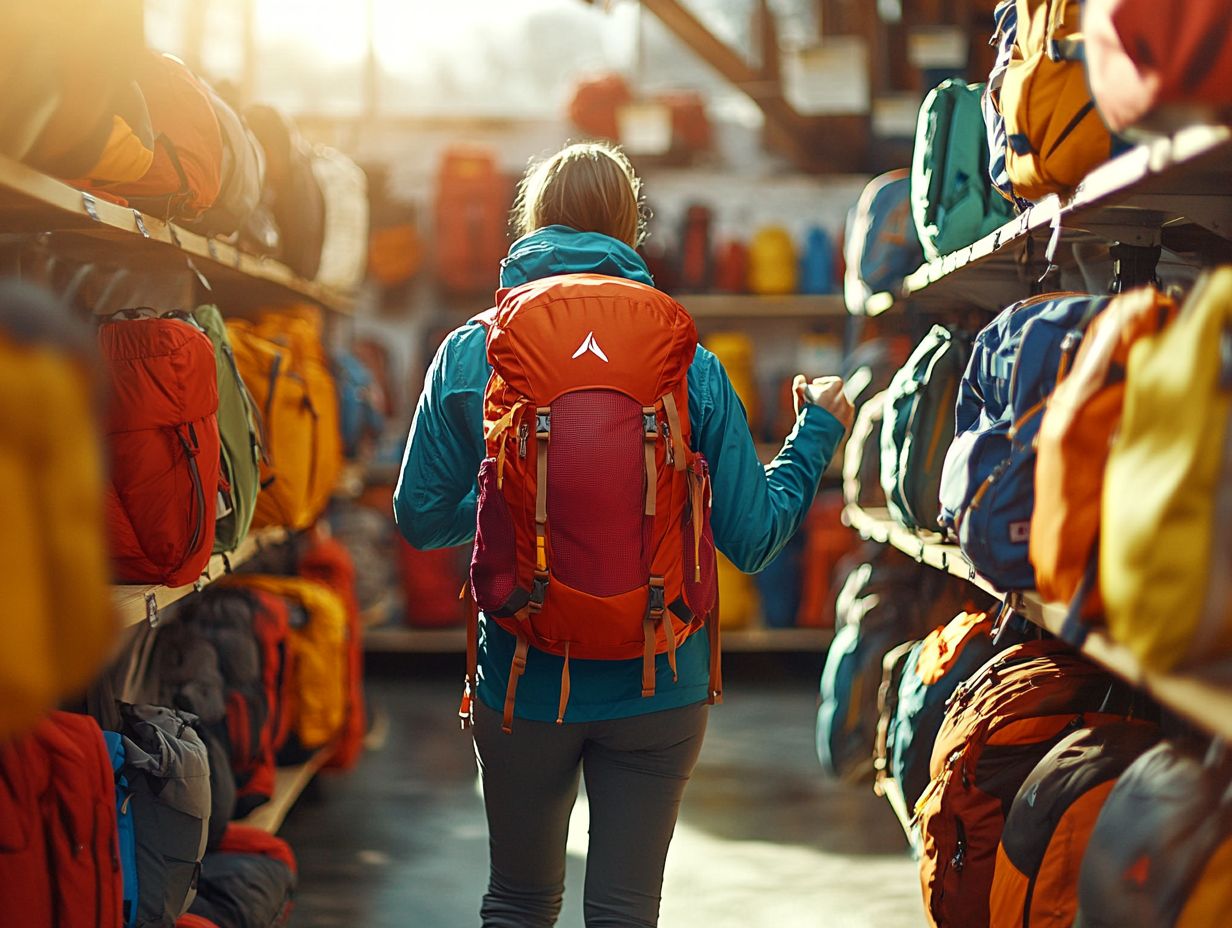
The materials and durability of a backpack are critical factors to consider. They dictate how well your pack endures the challenges of outdoor adventures and unpredictable weather conditions.
Take ripstop nylon, for example. It’s a top pick among hikers due to its lightweight nature and reinforced weave, significantly reducing the chances of tears and punctures. This is ideal if you frequently tackle strenuous hikes or navigate rugged terrain.
Then there’s Dyneema, celebrated for its remarkable strength-to-weight ratio. It offers excellent resistance to abrasion and water, ensuring your gear stays dry even during unexpected downpours.
These materials enhance the overall lifespan of your backpack and influence its performance across various hiking scenarios, from quick day trips to extended excursions in demanding environments.
Features and Organization
The features and organization of a backpack are crucial to its functionality. They enable you to efficiently store and access your gear during outdoor adventures.
A well-designed backpack often boasts multiple pockets and compartments that promote an organized layout. This makes it easy to locate essential items like water bottles, first aid kits, or tools without rummaging through your entire pack.
Some models even feature advanced compression systems that stabilize your load while you re on the move. This helps maintain balance and enhances comfort, ensuring a more enjoyable experience on the trail.
Types of Hiking Backpacks
Understanding the different types of hiking backpacks available is vital for choosing the perfect pack tailored to your needs. Whether you’re embarking on a day hike or heading out on an extended adventure, the right backpack makes all the difference.
Daypacks
Daypacks are your go-to solution for short hiking trips, typically lasting less than a day. They offer a lightweight and compact way to carry essential gear without unnecessary bulk.
These packs generally range in capacity from about 15 to 30 liters, providing just the right amount of space for water, snacks, and a first aid kit. Many daypacks come equipped with multiple compartments, pockets, and hydration reservoirs, ensuring you can easily access your items while on the move.
Renowned brands like Osprey, Deuter, and REI offer models that effectively blend durability with convenience. This helps you find the perfect fit for your outdoor adventures. To ensure you select the best gear, it’s important to learn how to choose the right sunglasses for hiking. The lightweight design promotes comfortable and efficient hikes, allowing you to enjoy a stress-free experience on the trails.
In summary, choosing the right hiking backpack involves considering fit, material durability, and organization. Make an informed decision to enhance your outdoor experience!
Internal Frame Backpacks
Internal frame backpacks are carefully designed to deliver exceptional weight distribution and comfort by keeping the load close to your body. They are the perfect companion for longer hikes and multiweek journeys.
This design enhances your maneuverability on rugged trails and significantly reduces strain on your back and shoulders. In contrast to external frame packs, which can feel bulky in tight spaces and may shift your center of gravity away from your core, internal frame packs offer a sleek silhouette that promotes balance and stability.
These packs typically include padded hip belts and adjustable suspension systems, which allow you to modify the fit for better support. When compared to other backpack types, the internal frame model shines in scenarios that demand agility and comfort. They are the go-to choice for adventurers ready to conquer diverse terrains with their hiking gear. Additionally, knowing how to choose the right hiking partner can enhance your outdoor experience.
External Frame Backpacks
External frame backpacks provide enhanced ventilation and load stability, making them perfect for carrying larger loads over extended distances and across rugged terrains.
These packs typically come with a structured frame that evenly distributes weight, allowing you to achieve better balance and comfort during long hikes or camping adventures. The open design promotes improved airflow against your back, significantly reducing sweat build-up an invaluable perk on hot days.
They excel in stability and comfort, but it’s worth noting that external frame models can be bulkier and less streamlined compared to internal options, making them less suitable for climbing or navigating technical terrain. Popular models like the Kelty Redwing and the Osprey Aether exemplify these advantages, offering rugged reliability and ample storage. For those looking to find the perfect route for their adventure, understanding how to choose the right hiking trail is especially beneficial for backpackers embarking on multi-day journeys into the backcountry.
Hydration Packs
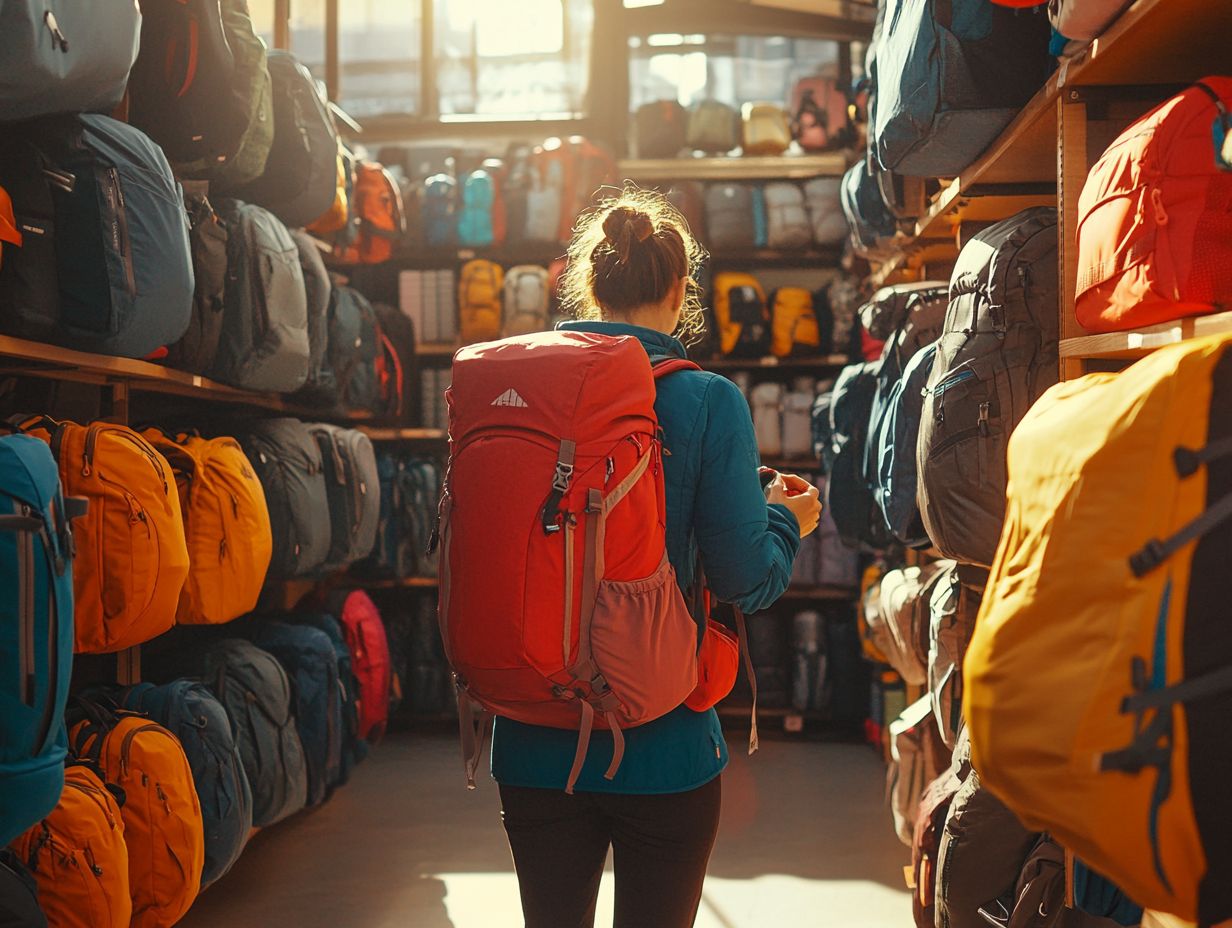
Hydration packs are specially designed backpacks that offer you effortless access to water, making them an exceptional choice for staying hydrated during shorter hikes and intense activities.
These innovative packs come with built-in water reservoirs, allowing you to sip on the go without the hassle of stopping to search through your gear. Many feature a hydration tube that conveniently routes around your shoulder, allowing for quick sips while keeping your hands free for climbing or navigating tricky terrain.
The thoughtful design includes storage compartments for essentials like snacks, maps, and tools. This makes these packs a practical companion for your hiking adventures.
When you pair them with larger backpacks for extended trips, hydration packs ensure your vital hydration needs are seamlessly met, allowing you to stay focused on the journey ahead.
Tips for Properly Packing a Hiking Backpack
Packing your hiking backpack correctly is key to your comfort and balance. The way you distribute weight within the pack can profoundly influence your overall experience on the hiking trails.
Distributing Weight and Balancing the Load
Distributing weight and balancing the load in your hiking backpack are essential for ensuring both comfort and stability throughout your trek. This significantly reduces fatigue while adjusting the fit of your hiking gear.
By strategically placing heavier items closer to your back and positioning lighter gear higher up, you create a stable center of gravity that allows for easier maneuvering along the trails. For example, when gearing up for an overnight hike, consider placing your tent and cooking equipment at the bottom of the pack, snug against your back for optimal support. Additionally, don’t forget to learn how to choose the right hat for hiking to protect yourself from the elements.
Keep items like snacks and a first-aid kit at the top for quick access. Utilizing compression straps not only secures your load but also keeps it centered, minimizing strain on your shoulders and enhancing your overall hiking experience with effective organization.
Pack smart and hit the trails with confidence!
Packing Essential Items
Get ready for adventure by packing smart! Packing essential items efficiently is crucial for ensuring you have everything you need for your hike while keeping your backpack organized and within the correct dimensions.
As you prepare for your outdoor adventure, think about essentials that address safety, sustenance, and comfort. Don’t compromise on safety; pack a first aid kit, a whistle, and a flashlight. These can truly make a difference in unexpected situations. Adequate food supplies, such as energy bars, trail mix, and hydration packs, are vital for maintaining your energy throughout the trek. Additionally, consider learning how to choose the right footwear for hiking to ensure comfort on your journey.
Regarding clothing, layering is your best friend for adapting to changing weather conditions. Pack breathable, moisture-wicking fabrics alongside a reliable waterproof jacket to enhance your overall experience.
By organizing these items into distinct compartments, you can ensure quick access, eliminating unnecessary interruptions during your journey while enhancing the organization of your backpack.
Adjusting and Securing Straps
Adjusting and securing the straps of your hiking backpack is crucial for a comfortable fit and effective load distribution. Ensure that the sizing of straps is appropriate.
When you adjust the shoulder straps correctly, they should rest comfortably on your shoulders without pinching or sliding off, allowing for free movement. It s equally important to position the hip belt securely on your hips, as this is where most of the load should rest for optimal support.
Engaging the load lifters located at the top of the shoulder straps helps tilt the top of the backpack closer to your body, reducing strain on your back. For more tips on proper packing techniques, check out our guide on how to pack a backpack for hiking. These adjustments enhance your comfort during the trek and significantly boost your safety by preventing unnecessary weight shifts or imbalances that can lead to fatigue or injury on the trails.
Frequently Asked Questions
What brands should I consider when looking for outdoor gear?
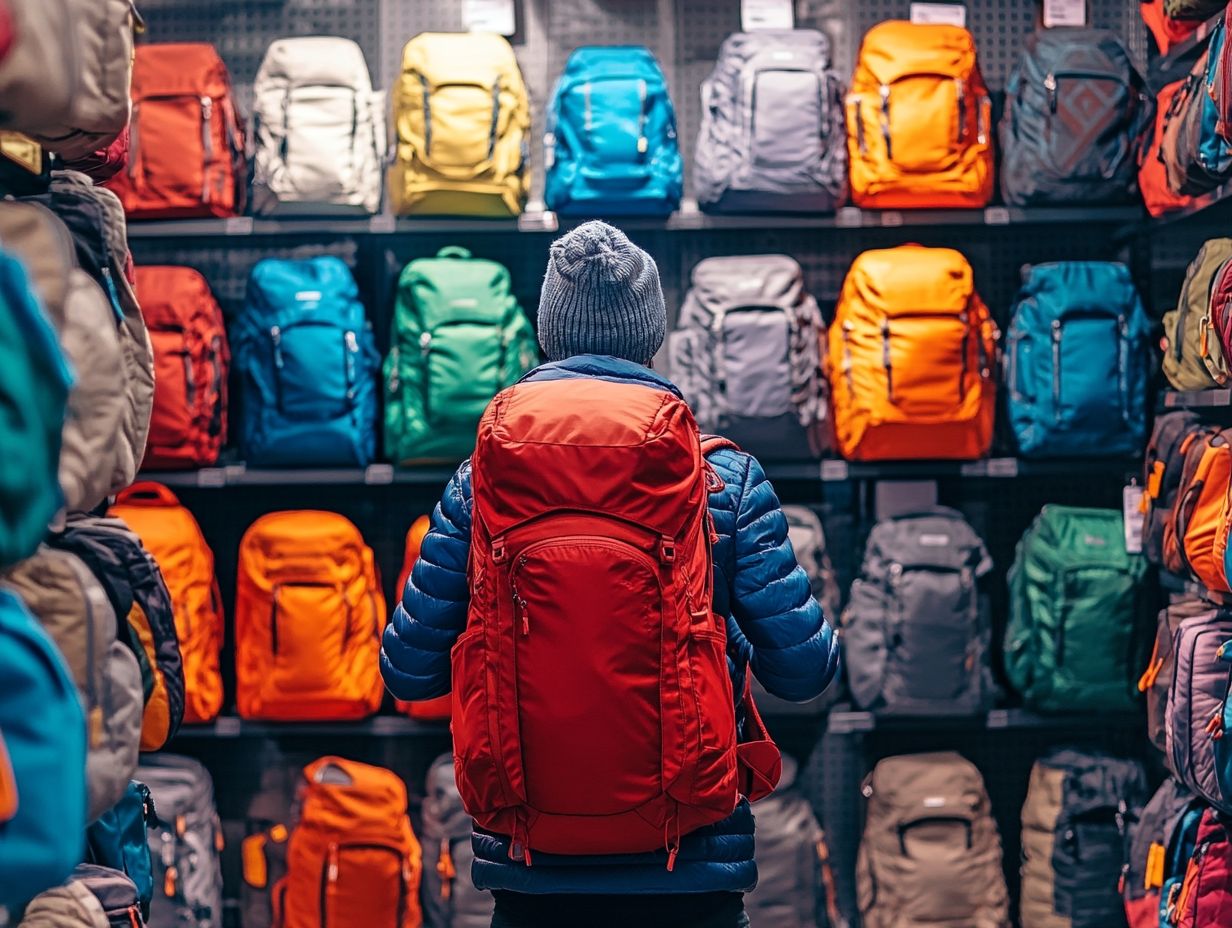
When looking for outdoor gear, some reputable brands include Osprey, REI Co-op, Hyperlite Mountain Gear, and Zpacks. They offer a variety of durable and comfortable options suitable for various hiking adventures.
What factors should I consider when choosing a backpack for hiking?
When selecting a backpack, consider the size, weight, durability, comfort level, and features such as compartments, hydration compatibility, and ventilation. Additionally, measurements like your torso length and hip circumference are essential for a proper fit and comfort on the trails.
What size backpack should I get for overnight hiking trips?
For overnight hiking trips, a backpack with a capacity of 40-50 liters is typically recommended. This allows enough space to fit all necessary gear and supplies without being too heavy.
Should I prioritize weight or durability when choosing a backpack for hiking?
It s important to strike a balance between weight and durability when choosing a backpack. A lightweight option may be comfortable, but it might not hold up well on rugged terrain. Look for a backpack that is both lightweight and durable.
What type of backpack straps should I look for in a hiking backpack?
When choosing a hiking backpack, look for adjustable and padded shoulder straps, as well as a hip belt for added support. These features help distribute the weight evenly and minimize discomfort on longer hikes while enhancing comfort features.
Have any tips or experiences to share? Join the conversation and let us know!
Are there specific features to look for in a hiking backpack?
When choosing a backpack for hiking, size, weight, and straps are important. Look for features like multiple compartments, compression straps, and hydration compatibility.
Good ventilation is crucial to stay cool and dry. Check the backpack’s capacity to make sure it fits your travel and packing needs.
Should I try on backpacks before purchasing one for hiking?
Yes! Trying on backpacks is a must before buying. This lets you test the fit, weight distribution, and comfort.
Adjust the straps and walk around to get a feel for it. A good fit is essential for your outdoor adventures!

